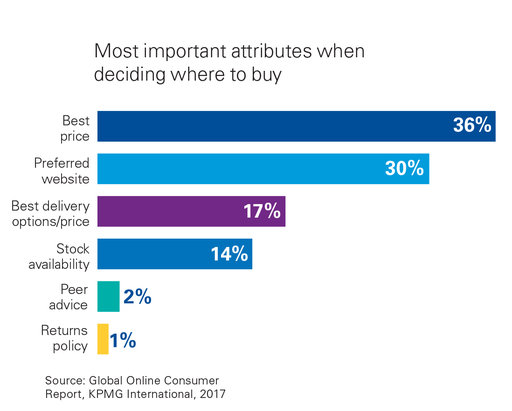If your pricing isn’t right, shoppers will never complete the path to purchase. Shoppers land on your site for a number of reasons. They might be a lifelong customer who pops onto your site to look for new products or to buy something on sale that they just got an email about. Or maybe they were searching for a certain type of shoe, and your ad came up first. Either way, getting a shopper to your site takes considerable work in terms of ranking well on search engines and having the most appealing images in your ads. But once they get to your website, a whole new caliber of work begins.
How the Path to Purchase Has Changed
The shopper path to purchase was never a clean-cut, linear process, but with the rise of eCommerce, it got much more complicated. That’s because there are now many new entry points to this path, whether that means an ad on a social media site or a direct site visit. Then, along this new path to purchase, there is the potential for many more touchpoints. A shopper no longer has to walk into your store to get more information on the product that caught their eye—they can check out your website for more information at any time of the day and from anywhere on mobile devices.
This is a good thing for retailers because they have more opportunities to nudge shoppers along the path. Encouragement can take the form of retargeting ads or email reminders for items they put in their cart but didn’t buy. There are three stages in the path to purchase: discovery, consideration, and purchasing. Let’s go over how your pricing impacts the movement along these stages.
Discovery
There are many ways shoppers can discover your products. Maybe all their coworkers are raving about a new coffee mug, or they have been thinking of getting a new rain jacket and searched for top brands. KPMG studied path to purchase and how it is changing in the eCommerce era. They found that “52 percent of consumers cited at least one offline channel as a source of initial awareness, and 59 percent cited one or more online channels.” While online channels are growing in importance as digital natives gain more and more spending power, it’s clear that significant resources and time still need to be spent on traditional forms of marketing.
When a shopper is just beginning to think about buying a product, pricing plays a big role. The first price they see serves as an anchor price, which they will use to compare all other prices to. That means that if your ads are a shopper’s first point of contact, then they need to have prices that fit in with the rest of the market to keep them in the buying cycle. Otherwise, compared to competitors, a high price will ensure they don’t buy from you (unless you have other value points that distinguish you from competitors, such as shipping, service, etc.), and a price that’s much lower than others will have them wondering if you’re a legitimate seller. To advance past this initial awareness phase, you’ll have to conduct competitor research and change your pricing to arrive at an amount that consumers will find acceptable.
Consideration
Once a shopper decides they’d like to buy a certain product, the hunt begins to find the right retailer from which they can purchase it. The right retailer will have robust product information, reviews for reading through, good shipping and return policies, and, of course, a fair price. KPMG found that the most important factor for shoppers when deciding where to buy was the retailer with the best price. What’s more, “price or promotions (identified by 27 percent of respondents) were the factors most likely to influence consumers’ decision regarding which product or brand to buy online.”

Don’t mistake this data as evidence for a race to the bottom. Reputable sites and sellers are much more likely to get shopper dollars, as they have social proof built in. When a shopper has had (or has heard of someone else having) a good experience with a retailer, then even if that retailer doesn’t have the lowest price, it’s much better than taking a gamble on a retailer they’ve never heard of and whose website looks like it was last updated in 2003.
During the consideration phase, the right pricing strategy will largely depend on the price tier of the product. For commodity items, coupons and charm pricing (tacking a .99 on the end of the price, or otherwise using nines in the price) can help get shoppers closer to checkout. For big ticket and luxury items, firm and whole number pricing can help solidify the high value of the product. Apple, for example, rarely discounts their MacBooks and never includes cents in their pricing. This fits with the prestige and demonstrated quality of the brand. Aligning your brand identity and the specific product type with pricing is the best call for retailers across verticals.

Purchase
Actually pulling the trigger on a purchase takes time and effort for retailers. The path to purchase is a cycle, and shoppers can easily switch stages, say if they find bad reviews or read the product specifications and realize it won’t meet their needs after all. The role of pricing in the path to purchase is to encourage shoppers to move forward. It shouldn’t be a blocker by being out of line with expectations or market trends. “Limited time only” discounts are typically effective in getting shoppers to check out faster, but that only works for certain product categories and pricing tiers.
Keeping Shoppers Coming Back
Even when you’ve successfully gotten a shopper to buy from you, the path to purchase should be ongoing. Encourage shoppers to write reviews to increase your social proof with other consumers. Also, provide repeat shoppers with spot-on recommendations, such as the perfect shirt to go with the pair of pants they bought a few days ago. Once you get to know a customer, the key to gaining their loyalty is providing a personalized relationship going forward.
Contributing Writer: Angelica Valentine















1 Comment